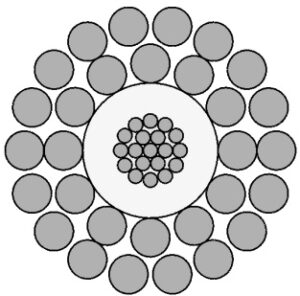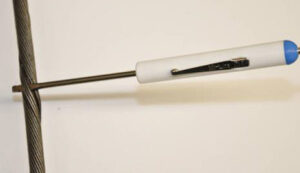Loose outer armor wire leads to bird cages, premature cable breaks, and drum crush. There are some general operating practices to reduce the chance of the outer armor wire getting loose, as well as quick and easy field tests to know when the armor is loose. Following these guidelines and knowing when to take the cable to a qualified service center will increase cable life.
Why does the armor get loose?
 All cables used in oil field service operations generate torque directly proportional to the load on the cable that is inherent in the design of the cable armor package. The torque of the outer armors is typically two times the opposing torque of the inner armors because, generally, there are more wires on the outer armors, and the distance to the center is larger. When lowered into the well, the tool end of the cable will try to rotate in a direction to unwind the outer armor, which will shift part of the load carried by the outer armor to the inner armor until there is a torque balance in the cable.
All cables used in oil field service operations generate torque directly proportional to the load on the cable that is inherent in the design of the cable armor package. The torque of the outer armors is typically two times the opposing torque of the inner armors because, generally, there are more wires on the outer armors, and the distance to the center is larger. When lowered into the well, the tool end of the cable will try to rotate in a direction to unwind the outer armor, which will shift part of the load carried by the outer armor to the inner armor until there is a torque balance in the cable.
As you pull a cable out of the hole, the cable tension increases by the frictional drag on the cable, which is proportional to the speed. The cable will rotate in a direction to further unwind the outer armor in proportion to this increased tension. The greater the speed, the greater the frictional drag, and the more the outer armor will unwind. As you lower the cable back into the hole, the tension reduces, and the cable will try to rotate in the opposite direction to tighten the outer armor again. The faster you lower the tool, the cable has less time to rotate back to a somewhat normal condition.
This combination of fast speeds in and out of the hole will ultimately form loose outer armor and bird cages. Once a bird cage is formed, the inner armor carries the entire load, and the cable-breaking strength is now that of the inner armor only or about 40% of the cable-rated breaking strength.
RULE OF THUMB:
‒ While going in the hole, do not allow the tension at any depth to fall below 2/3 of the static tension at that depth.
‒ Come out at speed no greater than the speed that increases the tension by more than 1 1/3 of static tension at that depth.
In addition to operating speeds, other factors can contribute to the outer armor becoming loose, including:
• Hydraulic pack-offs too tight.
• Flow Tubes do not have enough clearance; recommend minimum tolerance of 4,000 to 6,000.
• Using poly cables in wells with too high a temperature for the plastic sometimes results in excessive embedment of the inner wires into the plastic, resulting in loose outer armor.
How do you tell when the armor is loose?
As manufactured, the cable’s outer armor wires are pre-formed to a diameter less than its diameter on the cable, so the outer armor wires are tight even at no cable tension. There is no precise tool for measuring “loose armor.” Still, field experience shows that if a small screwdriver blade twisted between outer armor wires can easily move the wires during a time of no tension, it is time to have the cable armor tightened and set with post-forming.

There are several tell-tale signs that a cable is loose, including:
- The cable will not lay straight on the ground (torque in the cable).
- Mark the cable with paint near the wellhead, and watch the rotation as the cable moves toward the truck. If there is more than one rotation under normal operating tension, the cable may require servicing. When the tension on the cable is released, check the looseness with a small screwdriver, as discussed above.
- The top sheave will turn sideways when the tension slacks off, indicating torque in the line.
- Sour service alloy lines loosen very quickly. They should be inspected after every job, taken to a service shop, and tightened if required.
What to do when the armor is loose?
The cable is at high risk when the armor is loose and requires servicing. To tighten the outer armor, the cable service center will set up the cable payoff spool on a rotating platform, as depicted to the right. As you slowly pull the cable off the truck, inspect the degree of looseness of the armor every few feet. As you install the cable back on the drum, rotations of the payoff spool increase as needed along the cable length to tighten the cable. Different parts of the cable may require more turns than others. If adequately monitored, a cable only needs up to 10 turns per 100 feet at the deepest end. Cables that have been neglected or used under severe conditions can require 15-20 or more turns. Under certain conditions following the tightening process, the cable is passed through a series of off-set rollers to set this new condition.

